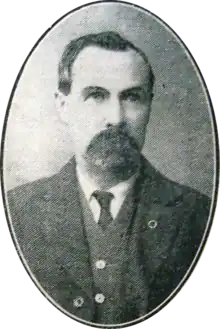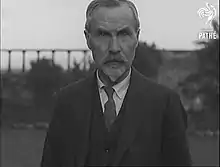Domhnall Ua Buachalla | |
|---|---|
 Domhnall Ua Buachalla c. 1916 | |
| 3rd Governor-General of the Irish Free State | |
| In office 27 November 1932 – 11 December 1936 | |
| Monarchs | |
| Preceded by | James McNeill |
| Succeeded by | Office abolished |
| Teachta Dála | |
| In office June 1927 – February 1932 | |
| Constituency | Kildare |
| In office May 1921 – June 1922 | |
| Constituency | Kildare–Wicklow |
| In office December 1918 – May 1921 | |
| Constituency | Kildare North |
| Personal details | |
| Born | 3 February 1866 Maynooth, County Kildare, Ireland |
| Died | 30 October 1963 (aged 97) Dublin, Ireland |
| Spouse |
Sinéad Walsh
(m. 1891; died 1918) |
| Children | 7 |
Domhnall Ua Buachalla (Irish: [ˈd̪ˠoːnˠəl̪ˠ uə ˈbˠuəxəl̪ˠə]; English: Daniel Richard "Donal" Buckley; 3 February 1866 – 30 October 1963) was an Irish politician and member of the First Dáil who served as third and final governor-general of the Irish Free State and later served as a member of the Council of State.[1]
Early life
Ua Buachalla was born in Maynooth in County Kildare on 3 February 1866.[2] His birth was registered as Daniel, the son of Cornelius Buckley, a shopkeeper, and Sarah Buckley, née Jacob.[2] He married Sinéad Walsh in Dolphin's Barn, Dublin on 3 June 1897.[3] After his marriage, he and his family lived in Maynooth,[4][5] where he ran a combined grocery, bicycle shop and pub in the town. He was an Irish language activist and member of Conradh na Gaeilge. In 1907, he was arrested and had his groceries seized when he refused to pay a fine for having his grocery wagon painted with Domhnall Ua Buachalla (his name in the Irish language), as British law required grocery wagons to be registered only in the English language.[6]
1916–1932
He was a member of the Irish Volunteers and on the outbreak of the 1916 Easter Rising he walked the 26 kilometres to Dublin to fight in the Rising.[7] He was imprisoned in the mass arrests and deportations that followed, and released in 1917. Like many Rising survivors, he joined Sinn Féin, a small separatist party that was wrongly blamed by the British government for the Easter Rising. In the aftermath of the Rising, survivors led by Éamon de Valera took over the party in the struggle for the establishment of an Irish republic. Ua Buachalla was elected as a Sinn Féin MP for Kildare North at the 1918 general election. He served in the First Dáil (1918–1921), and was re-elected to the Second Dáil in 1921 as a Teachta Dála (TD) for Kildare–Wicklow.[8] He sided with de Valera and opposed the Anglo-Irish Treaty. He fought in the Four Courts in the Civil War. Imprisoned in Dundalk jail, he was released by the Anti-Treaty troops in August 1922.[9] He lost his seat at the 1922 general election, and was an unsuccessful candidate at the 1923 general election.
Irish governor-general
He joined Fianna Fáil on its foundation in 1926 and was elected as a Fianna Fáil TD for the Kildare constituency at the June 1927 general election, only to lose that seat in the 1932 general election, which Fianna Fáil won.[10] He was chosen by Éamon de Valera to become Governor-General of the Irish Free State following James McNeill's resignation in November 1932.
Instruction to keep a low profile

De Valera explicitly instructed Ua Buachalla as Governor-General to keep a low public profile, and not to fulfil public engagements, which was part of de Valera's policy to make the office an irrelevance by reducing it to invisibility. While he continued to give royal assent to legislation, summon and dissolve Dáil Éireann and fulfil the other formal duties of the office, he declined all public invitations and kept himself invisible, as advised by his Government. In fact in his period in office he performed only one public function: the receipt of the credentials of the French Ambassador in the Council Chamber, Government Buildings, 1933, on behalf of King George V. However, de Valera subsequently had that duty moved from the Governor-General to his own post of President of the Executive Council; instead of presenting his credentials to Ua Buachalla, the US Legation Minister, William Wallace McDowell, presented himself to de Valera.[11] One of the few other occasions Ua Buachalla was mentioned at all in public was when, in the aftermath of the death of King George V in January 1936, he had to reply to messages of condolence sent to the Irish people by United States President Franklin D. Roosevelt and the United States Secretary of State Cordell Hull.
On de Valera's instruction, Ua Buachalla did not reside in the official residence of the Governor-General, the Viceregal Lodge (now called Áras an Uachtaráin, the residence of the President of Ireland).[11] Instead, a house was rented for his use in Monkstown, outside of Dublin.[12] The official English title "Governor-General" was largely replaced by the official Irish title "Seanascal" or its direct translation, "Seneschal"; however, "Governor-General" remained the legal form used in official English-language documents and proclamations.[13] Ua Buachalla refused all but £2,000 of the £10,000 salary of the Governor-General.
Falling out with de Valera
Ua Buachalla fell out with de Valera over the manner of his exit from office, in December 1936. De Valera sought to use the abdication crisis surrounding King Edward VIII to amend the Irish Free State's Constitution to abolish both the Crown and the office of governor-general. Having done so, he faced a threat of a court case from Ua Buachalla, who had been left personally liable for the remaining one year's expensive private lease on his residence, following the sudden abolition of his office. In practice, between 1933 and December 1936, the Irish government had paid Ua Buachalla expenses, from which he paid the rent on the expensive residence which was picked for him.
However, from December 1936, the government insisted that it had no responsibility for paying for the residence. Ua Buachalla had, in 1932, on de Valera's explicit advice, leased the residence for a full five years, which was his expected term of office. There remained one year's outstanding lease, for a residence he could not now afford and for which he had no need now as he was no longer governor-general. Eventually, de Valera was forced to grant Ua Buachalla a large pension and to pay his outstanding rent and expenses to stop a potentially embarrassing court case going ahead.[14] Ua Buachalla attended the inauguration of the first President of Ireland, Douglas Hyde, in Dublin Castle in June 1938.
Appointment to Council of State and later life
Ua Buachalla and de Valera reunited as political partners, and in a symbolic act of apology, de Valera, when elected President of Ireland in 1959 appointed Ua Buachalla to his advisory Council of State. However, he returned to Maynooth to continue running his family business, the hardware store which had been founded in 1853.
Domhnall Ua Buachalla died on 30 October 1963, aged 97, in a nursing home in Dublin.[15] He was given a state funeral and buried in Laraghbryan Cemetery in Maynooth, with the graveside oration delivered by President de Valera.[16]
The Ua Buachalla hardware store closed in October 2005. The road beside this store is named after him (although translated to English as "Buckley's Lane"). The building has been demolished, but some of the frontage has been preserved, with the building bearing the name "Buckley House".
References
- ↑ "Donal Buckley". Oireachtas Members Database. Archived from the original on 8 November 2018. Retrieved 20 August 2010.
- 1 2 "Births in the District of Maynooth in the Union of Celbridge, 1866" (PDF). irishgenealogy.ie. Entry Numbers 140–149. Retrieved 1 March 2021.
144 [..] Third February 1866 Maynooth [..] Daniel [..] Male [..] Cornelius Buckley Maynooth [..] Sarah Buckley formerly Jacob [..] Shopkeeper
- ↑ "Marriages in the Superintendent Registrar's District of South Dublin, 1897" (PDF). irishgenealogy.ie. Entry Numbers 135–138. Archived from the original on 25 September 2021. Retrieved 1 March 2021.
- ↑ "Residents of a house 7 in Leinster Street (Maynooth, Kildare)". census.nationalarchives.ie. 31 March 1901. Archived from the original on 25 September 2021. Retrieved 1 March 2010.
- ↑ "Residents of a house 29 in Main Street (Maynooth, Kildare)". census.nationalarchives.ie. 2 April 1911. Archived from the original on 25 September 2021. Retrieved 1 March 2010.
- ↑ "Irish Free State: King George's Domhnall". Time. 5 December 1932. Archived from the original on 27 October 2010. Retrieved 20 August 2010.
- ↑ Ua Buachalla, Domhnall (16 February 1949). "Bureau of Military History, 1913–21. Statement By Witness. Document No. W.S. 194" (PDF). militaryarchives.ie. Archived (PDF) from the original on 27 September 2020. Retrieved 1 March 2021.
- ↑ Coleman, Marie. "Ó Buachalla (Ua Buachalla), Domhnall (Donal/Daniel Richard Buckley)". Dictionary of Irish Biography. Retrieved 8 January 2022.
- ↑ "Biography of Ua Buachalla". archontology.org. Archived from the original on 6 August 2011. Retrieved 20 August 2010.
- ↑ "Donal Buckley". ElectionsIreland.org. Archived from the original on 22 February 2011. Retrieved 20 August 2010.
- 1 2 Seanascal Domnhall, TIME, April 9, 1934
- ↑ "Permalink - Stills Library - RTÉ Archives". 5 July 2012. Archived from the original on 2 October 2016. Retrieved 28 September 2016.
- ↑ Headed paper and seal of the Governor General (Seanascal) of the Irish Free State Archived 1 October 2016 at the Wayback Machine, National Library of Ireland
- ↑ "Executive Powers (Consequential Provisions) Act, 1937". Archived from the original on 14 July 2020. Retrieved 14 July 2020.
- ↑ "Deaths in the Superintendent Registrar's District of Dublin, 1963" (PDF). irishgenealogy.ie. Entry Numbers 426–435. Archived from the original on 25 September 2021. Retrieved 1 March 2021.
- ↑ "Funeral of Domhnall Ua Buachalla". Co. Kildare Online Electronic History Journal. Archived from the original on 29 January 2010. Retrieved 20 August 2010.
